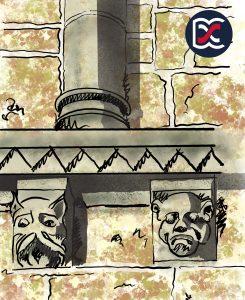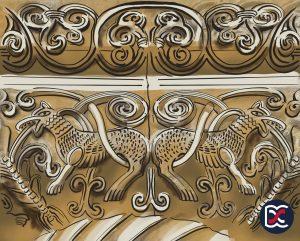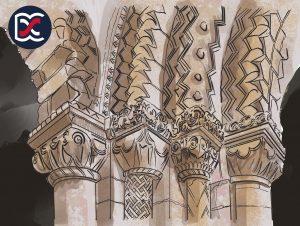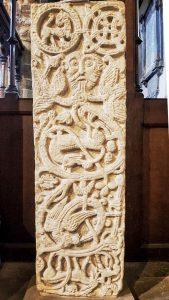St. Peter’s Church
Not forgotten of course but included in this series because of its stunning architecture and carvings. As one of the oldest surviving buildings in the town, it is steeped in history.
Archaeology suggests that there were two earlier Saxon churches on the site, one in wood, the other in stone, and today marked out in stones on the floor at the west end. The church which stands on the site today was probably built in the first half of the 1100s by Simon de Senlis II, the fourth earl. St Peter’s is constructed in reddish ironstone and yellowish oolithic limestone. Along both the north and south sides of the exterior of the clerestory are Norman arcades. Above these are a series of unusual corbels carved with mainly human and animal heads.
Legend says that the shrine of St. Ragener once stood in the church. St. Ragener was supposedly a nephew of the East Anglian king St Edmund, who was killed by Danes along with his uncle in 870. Although there is no evidence to support it, the legend claims that St. Ragener’s burial place was discovered in St Peter’s during the reign of King Edward the Confessor. Despite this, there was an altar to St. Ragener in the church as late as the 15c. A stunning stone slab carved with birds, beasts and what is probably a Green Man, can still be seen in the church, and has been associated by some with St. Ragener. It was rediscovered in 1843 being used as a door lintel in a nearby building.
In the late 1400s Northampton had become an important centre for the first protestants known as the Lollards. The Bishop of Lincoln sent a delegation to investigate in 1393. The situation which the commissaries discovered in Northampton was a very serious one, and according to the Bishop’s report to the government, a majority of the townspeople were infected with heresy. The Bishop came himself that September. An anchoress named Anne Palmer, who lived in a house adjoining St. Peter’s church was brought before him. She was accused of receiving Lollards day and night, held secret meetings, and also “publicly preached and maintained a number of heresies of the most extreme kind”. Anne flatly refused to answer the charges against her (except for an incidental charge of incontinence, which she denied) and referred to Bishop Buckingham as Antichrist and to his officials as Antichrist’s disciples. She was imprisoned in the bishop’s castle at Banbury until such time as she would agree to recant : she remained there throughout the winter, until on 26th March 1394 Buckingham was ordered to send her to London for examination by the royal council. We do not know her ultimate fate.
By 1575 Edmund Snape began to emerge as the town’s new radical religious leader. He took the deacon’s orders in 1575, but inclining to the Presbyterian views on ordination, he declared that he did not consider himself a full minister until he should be chosen by some particular congregation. Upon hearing this the parishioners of St. Peter’s, Northampton, immediately summoned Snape to be their minister. In 1586, Snape returned to St. Peter’s, and became Clerk of the Northampton Classis and a leading light of the larger meetings. The pursuivants poured into Northamptonshire to investigate the assemblies and practices of the puritans, who were attempting to introduce the discipline and usages of the Scottish and continental Presbyterian churches. It was the beginning of the suppression of the Puritans as they were commonly known. Agent Provocateurs began appearing in the county’s towns and famous local preachers were harried. Commissioners interrogated scores of preachers to gather information on the clandestine Presbyterian organisation. One of those targeted was Edmund Snape who they described as being or pretending to be the curate of St. Peters. Fearing a search for non-authorised books, he had his books carried to tanner George Bevis who hid them in his nearby bark-house. Snape, along with William Proudlove of Weedon Bec, Thomas Stone of Warkton, Edmund Littleton of Brixworth and Andrew King of Culworth were summoned to appear before the high commissioners in Jan 1590. They were held prisoner for the next three years.
The churches amazing carvings were plastered over in the seventeenth century…
The west tower had collapsed by 1607 and was rebuilt later that century. During the rebuilding it was moved 12 feet (3.7 m) to the east. The churches amazing carvings were plastered over in the seventeenth century but over eleven years during the early nineteenth century they were carefully unpicked with a bone knife by local antiquarian Anne Elizabeth Baker who lived in Hazelrigg House. In the 1850s the church was restored by George Gilbert Scott, this included re-roofing the church, rebuilding the east end and lowering the floor of the nave.
St Peter’s Church has been in the care of The Churches Conservation Trust Since 1998. Go see yourself! To find out more and when it is open or to join the Friends of St Peter’s see their website at https://www.fostp.org.uk/
Mike Ingram MA, Historian, Author, and Freeman of the ancient borough of Northampton
Established in 2003, David Cosby are a firm of Chartered Surveyors and Professional Estate Agents. We have the benefit of surveying and legal expertise to help facilitate the smooth sale of your home. With successful sales throughout Northamptonshire, we have a proven track record which is supported by impressive Google reviews.
For a free market appraisal or further information on how we can assist in the sale of your home please visit our Estate Agency Home Page or call us on 01327 361664.





